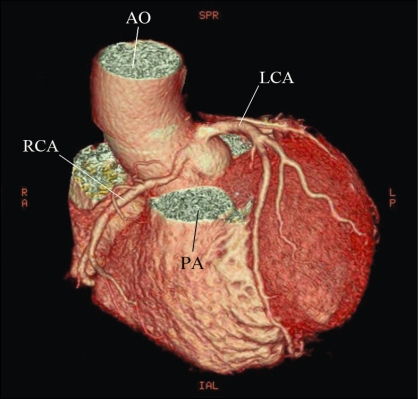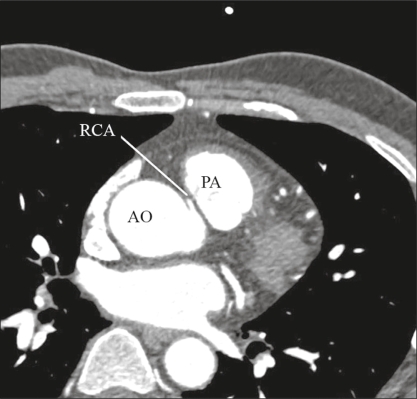Abstract
A 50-year-old man without previous coronary disease presented with an inferior myocardial infarction following exercise. He was initially treated with thrombolytic therapy and nitroglycerin. Subsequent coronary angiography and cardiac computed tomography demonstrated an anomalous right coronary artery originating from the left coronary sinus and passing between the aorta and main pulmonary artery. The coronary arteries were otherwise patent. The patient later underwent transaortic unroofing of the anomalous right coronary artery and was discharged in good condition.
Keywords: Anomalous right coronary artery, Congenital heart disease, Myocardial infarction
Abstract
Un homme de 50 ans qui n’avait pas eu de maladie coronarienne auparavant a consulté en raison d’un infarctus de la région inférieure du myocarde après avoir fait de l’exercice. Il a d’abord reçu un traitement aux thrombolytiques et de la nitroglycérine. La coronarographie subséquente a démontré une artère coronaire droite anormale provenant du sinus coronaire gauche entre l’aorte et la principale artère pulmonaire. Autrement, les artères coronaires étaient libres. Plus tard, le patient a subi une décompression transaortique de l’artère coronaire droite anormale et était bien quand il a obtenu son congé.
CASE PRESENTATION
A 50-year-old hypertensive man experienced his first episode of substernal chest pain several hours after jogging. His chest pain was associated with diaphoresis but no radiation or other symptoms. After 30 min of chest pain, he drove himself to a local hospital. His electrocardiogram demonstrated changes consistent with an acute inferior wall ST elevation myocardial infarction. He was treated with nitroglycerin and thrombolytic therapy. Coronary angiography revealed no obstructive coronary artery disease, but demonstrated an anomalous origin and interarterial course of the dominant right coronary artery (RCA).
A 64-slice computed tomography scan confirmed an anomalous origin of the RCA from the left coronary cusp. The RCA travelled between the aorta and pulmonary artery (Figures 1 and 2). The angle of origin of the RCA was acute with respect to the aortic wall, and there was narrowing of the proximal portion of the RCA, related to the intramural course.
Figure 1).
Reconstructed computed tomography scan of the right and left coronary arteries (RCA and LCA, respectively), both arising from the left coronary cusp. AO Aorta
Figure 2).
Axial computed tomography scan demonstrating the right coronary artery (RCA) arising from the left aortic cusp and coursing intra-arterially between the aorta (AO) and pulmonary artery (PA)
The patient was referred to the Mayo Clinic (Rochester, Minnesota, USA) for surgical management. Intraoperative transesophageal echocardiography again demonstrated an anomalous RCA that passed between the ascending aorta and the main pulmonary artery. The left ventricular size and systolic function were normal, with an ejection fraction of 62%. There was mild hypokinesis of the basal and mid-inferior wall.
Transaortic unroofing of the origin of the anomalous RCA and right coronary osteoplasty were performed. Intraoperative findings included a markedly narrowed right coronary ostium (less than 1.5 mm). After the intramural portion of the RCA was incised and reattached, the new ostium was widely patent (more than 3 mm). The patient’s recovery was uneventful and he was discharged on postoperative day 4.
DISCUSSION
There is now considerable evidence that an anomalous origin of the RCA is a significant risk factor for sudden cardiac death (1). Several studies have demonstrated that 0.03% to 0.9% of patients undergoing cardiac catheterization have an anomalous RCA (2). Our patient is unique because he was older than usual at the time of presentation and he suffered a myocardial infarction without previous cardiac symptoms.
Death due to complications of an anomalous coronary artery is quite rare, but often receives considerable media attention due to its association with young competitive athletes. Although symptoms of an anomalous RCA may appear at any time in a person’s life, it most commonly presents in younger patients (less than 30 years of age) and is strongly correlated with exercise (3). While clinical symptoms often do not occur, patients have been reported to experience syncope and angina before death (2,3).
There have been several proposed mechanisms to explain the increased risk of sudden death in patients with an anomalous RCA, including acute angulation of the coronary takeoff, which may become kinked and occluded during exercise; compression of the anomalous RCA by the aorta and pulmonary artery; vasospasm of the RCA; and endothelial injury and atherosclerosis due to turbulent blood flow (3,4). It has also been suggested that additive myocardial damage from repetitive ischemic injury may predispose to lethal ventricular arrhythmias (3). Angelini (1) proposed that intussusception of the origin of the anomalous coronary artery predisposes it to hypoplasia and lateral compression, leading to decreased blood flow during periods of increased stroke volume.
In our patient, the proximal RCA was narrowed at its origin and along its course between the ascending aorta and pulmonary artery. The distal portion was widely patent. Several mechanisms may have contributed to the compromised coronary circulation after exercise. There was a relatively long intramural RCA segment (approximately 1.5 cm) that had a slit-like orifice and an acute angle of origin. All these factors likely increased the propensity for lateral compression of the anomalous vessel.
Surgical treatment options for anomalous RCA include reimplantation, coronary artery bypass grafting or transaortic unroofing of the RCA. Our patient was treated with transaortic unroofing, which involves entering the aorta and excising the common wall between the intramural portion of the RCA and the aorta. This leaves a new orifice of approximately 1 cm in length, which is then widely patent. Reimplantation is not recommended because it is difficult to inspect or modify the abnormal ostium, and coronary artery bypass grafting should be avoided in the absence of occlusive disease because competitive flow may occlude the bypass (5).
CONCLUSION
Anomalous coronary arteries may be incidental findings or can cause symptoms related to compromised coronary circulation. They may present with angina, syncope or sudden cardiac death, typically before 30 years of age. However, occasionally, clinical symptoms do not occur for many years. Clinicians must have a high index of suspicion, especially in patients with atypical symptoms. Coronary computed tomography angiography is the test of choice in patients with suspected anomalous coronary arteries. Surgical intervention should be considered for high-risk varieties of anomalous coronary arteries, as this is the only treatment that has been demonstrated to improve coronary blood flow, and carries a low morbidity and mortality.
REFERENCES
- 1.Angelini P. Coronary artery anomalies: An entity in search of an identity. Circulation. 2007;115:1296–305. doi: 10.1161/CIRCULATIONAHA.106.618082. [DOI] [PubMed] [Google Scholar]
- 2.Man-Hong J, et al. Anomalous origin of right coronary artery from the left coronary sinus: Incidence, characteristics, and a systematic approach for rapid diagnosis. J Interv Cardiol. 2005;18:101–6. doi: 10.1111/j.1540-8183.2005.04046.x. [DOI] [PubMed] [Google Scholar]
- 3.Basso C, Maron BJ, Corrado D, Thiene G. Clinical profile of congenital coronary artery anomalies with origin from the wrong aortic sinus leading to sudden death in young competitive athletes. J Am Coll Cardiol. 2000;35:1493–501. doi: 10.1016/s0735-1097(00)00566-0. [DOI] [PubMed] [Google Scholar]
- 4.Béïque F, Tran QH, Ma F, Rudski L, Daves S, Angelini P. Anomalous right coronary artery originating from the left sinus of Valsalva. J Cardiothorac Vasc Anesth. 2004;18:788–98. doi: 10.1053/j.jvca.2004.08.024. [DOI] [PubMed] [Google Scholar]
- 5.Gulati R, et al. Surgical management of coronary artery arising from the wrong coronary sinus, using standard and novel approaches. J Thorac Cardiovasc Surg. 2007;134:1171–8. doi: 10.1016/j.jtcvs.2007.02.051. [DOI] [PubMed] [Google Scholar]




